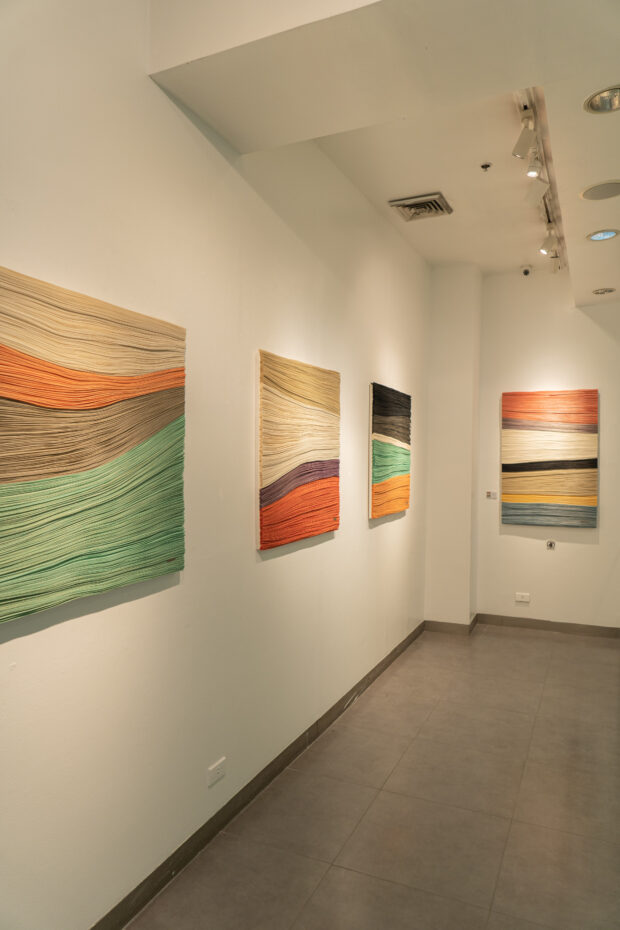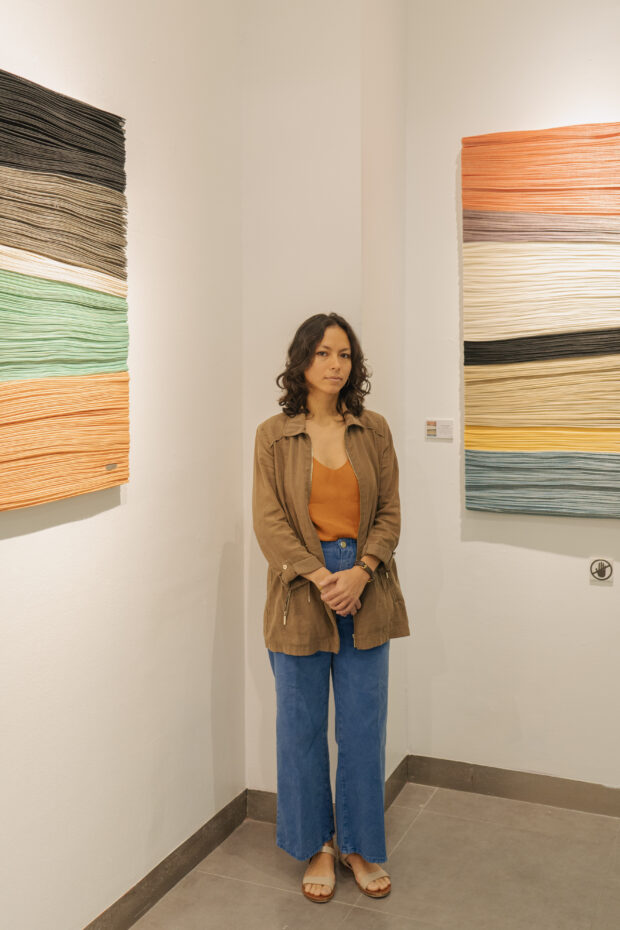Olivia d’Aboville has come a long way since graduating with honors in 2009 from Duperré, a prestigious Textile Design school in Paris. With a specialization in textile structures, she adapted her studies to make her own techniques shaping cloth. For her 10th solo exhibition, the French-Filipina artist continues to promote environmental sustainability through her artwork, now with influences from the color field movement and connecting to her life as a parent.
In 2010, I remember coming across her first exhibition at the Ayala Museum, “Chasm of Fantasies”. At the time, sustainability was not the trend it is today. I marveled at seeing plastic spoons molded like jellyfish. It brought to mind the photographs of Gutsy Tuason, with all kinds of weird and wonderful underwater creatures. Her work was lit up in the same way as the deep-sea bioluminescent animals, except sculpted out of recycled materials.
At present, she continues to find ways to incorporate sustainability into her artistic practice. From early sculptural works, she now moves to wall-mounted works that reference both her personal journey as a mother and an affinity for the ’60s color field movement. For her 10th solo exhibition “In Color” at Galeria Anna, this marks new changes in an evolving practice.

“In Color” Abstract Forms Inspired by Play and the Color Field Movement
Malasimbo festival-goers might recall her installations of recycled plastic resembling life-sized dandelions at the center of a grass clearing. After several years of going back and forth from Puerto Galera, d’Aboville relocated to Manila to give her two sons, aged seven and three years old, a steady arrangement for school.
Her latest work in abstract forms take after the experience of spending time with her two young sons, “I’m at home all the time–I’m a full-time mom and a full-time artist. The line is very blurred. I work every day but I’m a mom every day. I cater to their needs, 24/7. The show is really inspired by what I do with my kids, my daily life, and what we do together.”

The idea is tactile: “It’s about folding paper, doing airplanes. All these activities, drawing, painting. All these bursts of colors, uneven compositions, lines, and curves. These were inspired just by folding papers.”
This theme of play and lightness with her children connects to her vibrant wall-mounted textiles. She shares how she is drawn to the 1960s color field movement, “Just expression through blocks of color. Morris Lewis is one of my favorites. For these pieces, I went a little bit out of my usual, traditional frame, size, and shapes, but it’s also part of that same philosophy.”
Collaborating for Abaca Sustainability, From Farmer to Weaver Till Cooperative
Every bit of material in the exhibit is hand-woven and custom-made. She credits a team of artisans who help construct her work into contemporary art pieces. From the Abaca farmers to the weavers, d’Avobille says, “Before I actually handle the fabric itself, it goes through so many other hands before mine. There are so many stories in there.”
As she moves her hands through the fibers, she can detect differences that tell stories of what the weavers may have felt– “Imagine the weaver putting her strength in if she’s tired that day or if she has issues. The intensity she will put into the weaving would be different than if she’s having an easy day.” Sometimes she’ll notice the fabric is sheerer, so the intensity wasn’t as strong. Other times the tones will be darker, with a pearly hue, or shine. Each work of the Abaca weavers and farmers has a sense of uniqueness in the threads. Subconsciously or not, this passes through d’Aboville’s mind. She says,
“There’s a lot of energy in there. That’s why I love working with fabrics.”
While Abaca is one material d’Aboville has been working on for many years, her initiative has grown from collaborating with the local farmers and artisans to the Filipino-French Community. She works with Cebu-based cooperative “Interlace”, run by a Frenchman Francis Dravigny. Dravigny settled in the province 30 or more years ago and divides his time with Lyon, France. His clients are the “top of the top” d’Aboville says, from Chanel to Dior and other boutiques. “To have clients like that, it shows that Abaca is a known fiber and appreciated, more so now.”
The Nitty Gritty: Pleating, Hand-Stitches, and d’Aboville’s finishing touches
As an artist, d’Aboville is open and forthright as she reveals the techniques in her process. Taking a scrap piece of paper, she demonstrates a complex series of folds. She indicates a diamond pattern is hand-stitched every seven centimeters. Collectors will be relieved to know the extremely tight pleating makes the artwork easy to preserve, too.
While d’Aboville conceptualizes and composes the colored shapes, she also cuts and cleans the edges. She points to a small part of an artwork, “Imagine here—It’s a small artwork, only 90 centimeters. But if you stretch out the whole fabric, it could be 20 meters in there. So I cut 20 meters ever so slowly.”
For the artworks in this exhibition, she used over 100 rolls of fabric, about 115 meters. One can only imagine how meticulous the process must have been.
The final product has an appealing, organic quality to it. To the gallerygoers, d’Aboville shares a secret, that the sewn back of the artwork is just as stunning. “That’s one aspect I should explore more,” she says. With her most recent elegant, yet meaningful series of work, now that d’Aboville is back in the art scene, it is exciting to imagine what she is going to create next.
—
“In Color” ran from March 12-25, 2023 at Galerie Anna, The Artwalk in SM Megamall.

